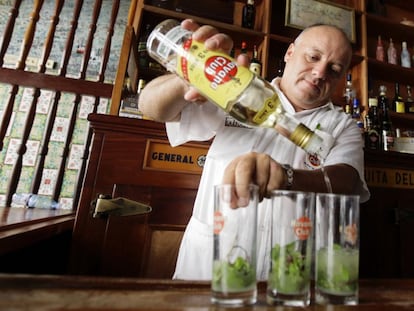Tourism amid power cuts and food shortages: Why does Cuba continue to invest in hotels?
Despite the fact that fewer and fewer visitors are traveling to the island and hotel occupancy has fallen, the government allocated almost 40% of its investments in 2024 to activities related to the industry
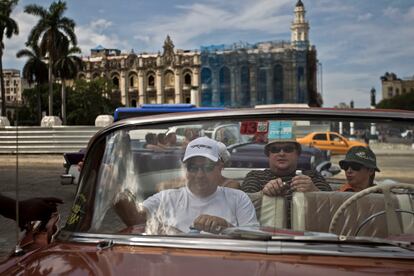

The bartender recalls the day when, while working in his cantina facing the Caribbean Sea, a German tourist ordered a fish fillet.
— “I don’t have any, sir. What I have is pork, beef, and chicken,” said the bartender, who won’t give his name because he’s not willing to lose his 25-year job at a hotel in Cayo Largo del Sur.
— “But you have all that sea and no fish?” the tourist replied.
On other occasions, the bartender has had to come up with a way to satisfy a customer. There was the case of a tourist who asked for a Cuba Libre, one of the most famous Cuban cocktails, made with white rum, Coca Cola, and lemon. If any of the above ingredients are missing, the bartender does not hold back: “I told him: ‘Look, I can’t make you a Cuba Libre, but I can make you something else.’ If I have lemon soda, I say that I am going to make an aphrodisiac drink that in my city is called Santo Libre. That is a lie, it is lemon soda with aged rum. But the customer accepts and I tell them: ‘Tomorrow, you tell me.’ Sometimes you solve the situation, but sometimes you can’t. Canadians are great beer drinkers and, if there is no beer, there is nothing to invent,” he says.
His hotel, a facility operated by the Gran Caribe group and the Blue Diamond company, is located in the Canarreos archipelago, a paradise in the southwest of Cuba. For him, there have been no better years than those between 2012 and 2015, when tourists arrived en masse at the hotel, on planes that left from Italy, Canada, or Germany and landed directly on the Cayo. Or American tourists, who reached a record number of 173,550 in 2014, the same year that former U.S. president Barack Obama announced the normalization of diplomatic relations with Havana.

“Right now, those direct flights don’t exist. Tourists come from Havana, Varadero, or other places in Cuba,” says the worker, who regrets not having ever seen the no vacancies sign at the hotel again, as it was in its golden days, when the 600 rooms that the facility has were occupied.
This week, for example, the hotel only has 90 rooms occupied, mostly by Canadian tourists, the so-called “snowbirds” who escape the cold to vacation in the tropics and who today fill the void left by other travelers. Last year alone, a million Canadian tourists passed through the island. But in general there is a drop in the number of visitors arriving in Cuba. And this is also seen in the deserted streets. More than three years after reopening the borders after the coronavirus pandemic, visitors are much fewer than the government expected, according to official figures. In 2023, they expected to receive 3.5 million tourists and only 2.4 million arrived. This year, the numbers are even more discouraging. Minister of Tourism Juan Carlos García Granda has confirmed that the country expects to close this year with the reduced figure of 2.2 million tourist arrivals.
Even so, the government continues to bet on the tourism industry as the driving force of the Cuban economy, amid an economic crisis that, according to researchers, surpasses the so-called Special Period. A report by the National Office of Statistics and Information (ONEI) confirms that, from January to June 2024, the authorities allocated almost 40% of their investments to activities revolving around tourism, such as hotels, restaurants, real estate, rentals, and business services, among others. The country invested 4.6 times more in the construction of hotel rooms and in business and rental services than in other currently deteriorating sectors such as education, health, or agriculture. This year, the government spent 4.931 billion pesos ($205 million) on hotels and restaurants, an increase of 112.1% compared to the 2.325 billion pesos invested in 2023.
“The destinations of the investments do not adequately weigh economic and social needs,” says Cuban economist Ricardo Torres, former researcher at the Center for Studies of the Cuban Economy and a professor at the American University of Washington. “It is true that not everything can be devoted to social programs, because investment must be made to ensure economic growth, but the current situation goes beyond any consideration of that type. Even from a productive point of view, multimillion-dollar resources dedicated to a sector in sharp decline are not justified. If they had been dedicated to other sectors, for example, energy and food, the situation would be different today.”
The question Cubans are asking themselves and the mystery that economists are trying to understand is this: in a country with a collapsed electrical energy system, with constant scheduled blackouts, and a food and health crisis with no recovery in sight, why does the government continue to allocate its resources to tourism?
“Tourism is not the locomotive it used to be”
“The poor numbers in the sector clearly reflect the nonsense of a strategy that builds very expensive hotels in the midst of the collapse of the rest of the country,” says Torres. “How can tourism flourish without electricity? I believe that the reasons for this decision, maintained for years, are not in the economy and frankly no authority has offered convincing explanations to the citizens.”
The economist believes that the government owes the people an explanation for the questions that many are asking in the streets, such as why there is no food in the grocery stores but there is in the hotels; why Cuba sells “health tourism” if the hospitals are overwhelmed; or why there is such a housing shortage while they continue to build gigantic hotels in the main areas of Havana.
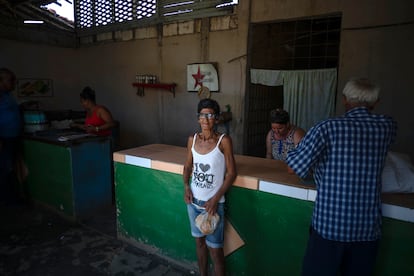
In the 1990s, with the economy depressed after the loss of aid from the USSR, Fidel Castro accelerated the development of the tourist industry to keep the country afloat with the foreign currency brought in by visitors. The state monopoly Gaesa, in the hands of the Revolutionary Armed Forces (FAR), together with its company Gaviota, began to create agreements with large hotel chains such as Spain’s Meliá and Iberostar for the construction of hotel rooms. The government also decriminalized the possession of dollars as part of the economic reform that allowed purchases with that currency in places previously reserved only for international visitors. For years, tourism was one of the main sources of foreign currency income for the country, after remittances and the sums brought in from the export of professional services, mainly medical.
“Although the performance was very improvable, it undoubtedly contributed to the economic recovery after the tremendous crisis of the 1990s,” says Torres. “Tourism was the only sector that, through various channels, left money for the government but also in Cuban homes. And that was greatly enhanced by the rise of the private sector, which became a leader in visitor services.” Ten years ago, Cuba became the vintage postcard in which millions of tourists wanted to appear. In the Obama era, almost five million U.S. tourists came to the island. Although Donald Trump later reversed the rapprochement and, among other things, restricted travel by American tourists or the services of cruise ships arriving on Cuban shores, in 2018 the island received 4.2 million tourists, and 4.6 million in 2019. The hardest blow to that industry was the coronavirus pandemic.
Almost terrified by the idea of border closures, the Cuban government was reluctant to completely abandon tourism revenues at the start of the pandemic and combined periods of total closure with others of a certain opening. During the latter, the authorities went so far as to encourage tourists to try Cuban vaccines against Covid-19, sold “confinement packages” for nationals or foreigners arriving in the country, and produced commercials such as: “Beach, Caribbean, mojitos and vaccines. All in one place.” In addition, the Cuban government continued to invest and build hotels in its main hubs. At that time, 45.6% of total investment was allocated to the sector, according to ONEI figures.
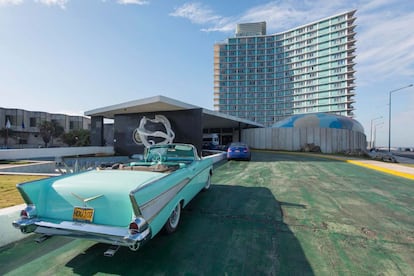
However, the coronavirus wreaked havoc on the Cuban economy, and the tourism sector collapsed. In 2020, 1,084,728 visitors were received. In 2021, 356,470. In 2022, the figure was 1.6 million. The European consultancy ForwardKeys stated that Cuba was the country with the worst tourism recovery in the Caribbean after the pandemic. Destinations such as Mexico or the Dominican Republic now occupy the top places in the rankings of the region. This year, the Dominican Republic will exceed 10 million tourists.
For economist Torres, “it is clear that tourism is not the driving force it once was, and it will not be so in the foreseeable future.” Even so, the government continues to bet its economy on this sector, despite the fact that pre-Covid figures have not been reached again and the low hotel occupancy rate, which this year was 28.4%, is evident. Omar Everleny Pérez Villanueva, former director of the Center for Cuban Economic Studies at the University of Havana, finds it difficult to understand why the Cuban state maintains these investments. “It could be due to many things. What I have been able to find out is that this credit was granted against an economic plan that anticipated a recovery in tourism,” he points out. “I would have a hard time thinking that the state is spending that money and yet does not have medicines for the population.”
“I think they were thinking that during the Biden era there could be an improvement, that there would be cruises, American tourists,” he adds. “But the conclusion is that the state concentrated a lot of money on a sector that is slowly recovering and neglected other important ones such as the energy industry or agriculture. That is inconceivable.” Furthermore, Everleny points to specific factors regarding the drop in tourists from other countries. Russian arrivals, for example, have decreased after the invasion of Ukraine. Meanwhile, Europeans could be dissuaded from traveling to the island by the restriction for those who go to Cuba and then want to enter the United States with an ESTA visa.
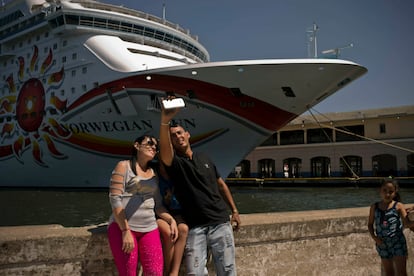
“Tourists don’t just come to hotels, they come to see Cuba”
Both economists agree that news of food shortages and power outages may also be driving away tourists. “No one is going to come to a country where there are long power outages, lasing 14 or 16 hours,” Everleny says. “No one is going to come to a country where the streets are unsafe, they have potholes. The hotels themselves leave a lot to be desired. There are no supplies.”
In fact, it is not uncommon to hear of tourists having bad experiences due to the situation on the island, such as a Canadian woman who had to undergo surgery and described the hospital as “a horror movie set,” or another who sued the travel company Sunwing after paying for a vacation at the Memories Varadero Beach Resort and facing shortages of food, toilet paper, and a lot of cockroaches. There was even a Canadian family whose relative died during their visit to the island, and the body of a Russian tourist was repatriated to them. Sunwing, a Canadian tour operator, withdrew 26 hotels in Cuba from its offers after the massive blackout in October. Samantha Taylor, marketing director of Sunwing, told the travel website Pax News that the situation “can shake consumer confidence.”
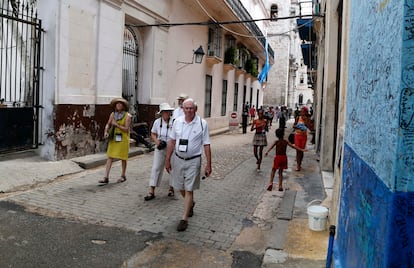
Concerned that tourists might be scared away by this news, the Cuban Ministry of Tourism has said that if there is one sector that is guaranteed electricity, it is the tourist sector. But even with electricity in the hotels, how do people get around? What kind of country will they find? Everleny believes that in Cuba “extra-hotel development” is necessary. “Tourists don’t just come to the hotels, they come to see Cuba, its streets, its people,” says the economist.
Meanwhile, the bartender at the Cayo Largo del Sur hotel experiences the drastic change in tourism in recent years on a daily basis. The so-called high season in Cuba began a month ago and there is no indication that it will continue. He also says that many workers have left their jobs. “There is a massive exodus of experienced personnel, people who spoke several languages. That has affected us a lot.” And tourists tell him that things are not the same as before. “The supply is terrible, sometimes there is no coffee, no sugar. I can understand that a hotel does not have a delicacy, but that there is no flour, no sugar... There have been days when there are no eggs in the hotel, and how do you explain to a Canadian that he has to have breakfast without eggs? Then the client feels cheated. We don’t understand why they continue to build new hotels if the ones you already have are falling apart.”
Sign up for our weekly newsletter to get more English-language news coverage from EL PAÍS USA Edition
Tu suscripción se está usando en otro dispositivo
¿Quieres añadir otro usuario a tu suscripción?
Si continúas leyendo en este dispositivo, no se podrá leer en el otro.
FlechaTu suscripción se está usando en otro dispositivo y solo puedes acceder a EL PAÍS desde un dispositivo a la vez.
Si quieres compartir tu cuenta, cambia tu suscripción a la modalidad Premium, así podrás añadir otro usuario. Cada uno accederá con su propia cuenta de email, lo que os permitirá personalizar vuestra experiencia en EL PAÍS.
¿Tienes una suscripción de empresa? Accede aquí para contratar más cuentas.
En el caso de no saber quién está usando tu cuenta, te recomendamos cambiar tu contraseña aquí.
Si decides continuar compartiendo tu cuenta, este mensaje se mostrará en tu dispositivo y en el de la otra persona que está usando tu cuenta de forma indefinida, afectando a tu experiencia de lectura. Puedes consultar aquí los términos y condiciones de la suscripción digital.
More information
Archived In
Últimas noticias
Chris Martin, Taylor Swift, Elijah Wood and other famous wedding ‘crashers’
‘How does it feel to be a failure?’: Elizabeth Berkley’s journey from ‘Showgirls’ ridicule to vindication
The story of the Málaga virus: The code that haunted Google’s cybersecurity center director for 30 years
The impact of Ecuador’s mega-prison: A polluted river, cleared forests and military checkpoints
Most viewed
- Christian Louboutin: ‘Young people don’t want to be like their parents. And if their parents wear sneakers, they’re going to look for something else’
- The low-cost creative revolution: How technology is making art accessible to everyone
- Liset Menéndez de la Prida, neuroscientist: ‘It’s not normal to constantly seek pleasure; it’s important to be bored, to be calm’
- All the effects of gentrification in one corner of Mexico’s Colonia Roma
- December Social Security and SSI payments: Dates, double checks and the 2026 COLA increase
